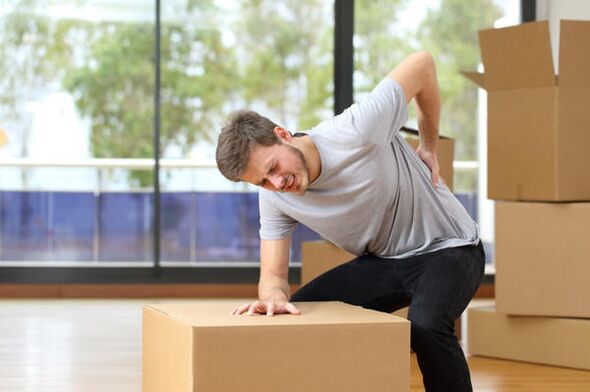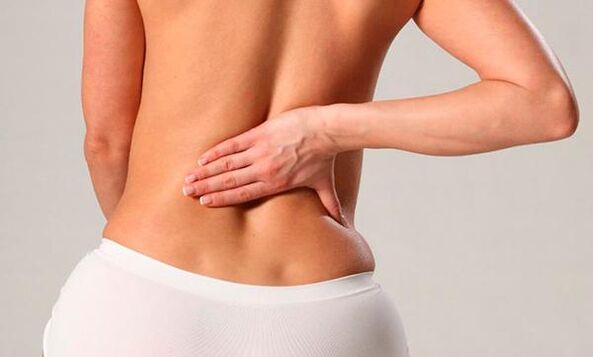Back pain is a fairly common symptom. Everyone has experienced it in one way or another in their life.
Causes, frequency, and risk factors for low back pain
Let's see why the lower back hurts in the country. In most cases, low back pain indicates that you have:
- Osteochondrosis and neuralgia;
- kidney disease;
- Acute pancreatitis.
Let's consider each possible cause in more detail.
Low back pain can occur with various kidney diseases:
- Glomerulonephritis - non-infectious kidney damage;
- Pyelonephritis - purulent inflammation of the renal pelvis;
- Formation and movement of stones in the kidneys and ureters.
Often, hypothermia, a cold, or diet can cause kidney disease. Lower back tears can easily be confused with kidney problems. However, there are some symptoms that are characteristic of this disease:
- Pain independent of exercise and physical activity;
- Body temperature often rises above 37. 5 degrees;
- Tapping the kidney area with the edge of the palm can cause severe pain;
- trouble urinating - frequently or too rarely, pain;
- Urine becomes cloudy and changes color.
When a person has kidney problems, the first thing to do is to call the doctor. The function this organ performs in the body is too important to risk. When the doctor comes to your country house, try to alleviate the patient's condition.
What can be done:
- Have the patient lie down or help him take a comfortable position;
- In the presence of temperature - give antipyretics;
- give sick antispasmodics, for example, no-shpu;
- Monitoring pressure and temperature;
- If the person needs to turn around, help if necessary.
It is often written that a warm compress or a warm bath can help with kidney disease. remember!
If the pain is caused by pyelonephritis, heating will only make the situation worse because the inflammation caused by the heat will increase.
All further measures can be prescribed by a doctor after a professional examination.
Injuries to the lumbar spine are the most common cause of low back pain.
Almost everyone experiences low back pain at least once in their lifetime. It should be noted that pain can occur anywhere in the back, however, lumbar pain occurs most often. This is because the lumbar spine bears the greatest load from your body weight.
Low back pain is the second most common cause of doctor visits, after viral infections. You may experience lower back pain after lifting heavy objects, moving suddenly, holding one position for an extended period of time, or after injuring your spine. The most common causes of acute lumbar pain are disc displacement and spinal trauma.
Conditions that can cause back pain:
- lumbar osteochondrosis
- Disc Herniation and Disc Herniation
- Spondyloarthropathy
- Spondylosis
- Spondylolisthesis
- Osteoporosis, Multiple Myeloma, Vertebral Hemangioma Compression Fractures
- Tumors in the spinal canal
Destruction of the lumbar spine in tuberculosis is a rare cause of low back pain.
- Spine fracture after injury
- chronic muscle tension
- Anatomically narrow spinal canal
- Spinal curvature (scoliosis, kyphosis, kyphoscoliosis, Scheuermann's disease Mau)
- aortic aneurysm
- Rheumatoid Arthritis, Psoriatic Arthritis, Osteoarthritis
- Spinal Infections - Osteomyelitis, Discitis, Spinal Tuberculosis
- pyelonephritis, urolithiasis
- complicated pregnancy
- Gynecological diseases (endometriosis, ovarian cysts, ovarian cancer, etc. )
Back pain with pancreatitis
Tumors in the spinal canal are a common cause of low back pain.
Pain may vary: sharp, dull, pulling, burning, possibly accompanied by tingling and goose bumps, numbness. Lower back pain varies widely in intensity—from mild to excruciating pain, even small movements are difficult. Pain can be combined with thigh pain, calf pain, and foot pain.
For low back pain, don't start with a spine X-ray.
- Reduce physical activity for the first two days after an attack. This will help reduce disease symptoms and swelling in the painful area.
- Do not sit forward until the pain has completely subsided.
- Pain medication is only taken when the pain is unbearable. Intramuscular injection is better than drinking anesthesia. This will protect your stomach lining from direct contact with the anti-inflammatory drug. Try to avoid taking too much medicine. If low back pain is not related to an autoimmune disease, do not use hormonal drugs to treat it.
- Sleep in fetal position with a pillow between your legs. If you usually lie on your back, put a pillow under your knees
- A common misconception is that you should limit physical activity for long periods of time. Bed rest is not recommended! If you don't have a fever, weight loss, involuntary urination and bowel movements, then you should stay active for as long as possible. You can only reduce activity for the first two days after the onset of pain. Start doing some light cardio. Walking and swimming on the simulator will help improve blood flow to the back muscles. Consult your doctor with exercise options that may increase pain.
A characteristic symptom of pancreatitis is low back pain, which begins below the left rib cage. It then spreads to the stomach and back, forming a ring. Pain in the navel area may also indicate pancreatitis. Back pain above the waist is not uncommon in atypical forms of the disease - they are often mistaken for symptoms of pancreatitis.
The back pain of acute pancreatitis is very severe. First aid for pancreatitis includes:
- starvation (patient should not eat before examination);
- comfortable posture (helping people accept it), peace and comfort;
- Drink in moderation (regular water can be given gradually);
- Disease control (do not leave the patient alone).
There are some body positions that help reduce pain: knee-elbow position and fetal position.
diagnosis method
First you need to see a neurologist. Your doctor will ask you questions about the nature, frequency, and recurrence of your pain. The doctor will try to determine the cause of the pain and start treatment with simple methods (ice, mild pain relievers, physical therapy, and necessary exercise).
MRI in 95% of cases will identify the real cause of back pain.
In most cases, these treatments can reduce back pain. During the exam, the doctor will determine the exact location of the pain, radiation, nerve reflexes. Most people with low back pain recover within 4 to 6 weeks. Diagnosis includes magnetic resonance imaging (English.
MRI) lumbar spine, lumbosacral spine computed tomography, spine X-ray. Since the most common cause of low back pain is a herniated lumbosacral disc, the first thing you need to do is get an MRI scan of the lumbar spine.
This study will also help rule out most causes of pain such as tumors in the spinal canal, spinal tuberculosis, spinal fractures, multiple myeloma, anatomically narrow spinal canal, spondylolisthesis, various types of spineCurvature, spondylosis and spondyloarthropathy.
If your neurologist didn't schedule an MRI for you, do it yourself. The power of the MRI machine should be 1 Tesla or more. You should not start with X-rays and computed tomography scans, these methods are not safe. It should only be done first if a spinal fracture is suspected.
Diagnosis is based on the patient's chief complaint, his external examination, medical history data, and the results of instrumental and biochemical studies. The most informative method for detecting musculoskeletal lesions is radiography. The resulting image clearly shows the deformed vertebral bodies and the reduced distance between them, as well as the formation of bone growths (osteophytes).
MRI, CT, and ultrasonography are performed if hernia herniation, herniation, or internal organ disease is suspected. These studies can detect the localization of pathology and assess the extent of the inflammatory process.
General clinical blood and urine tests are mandatory. If systemic disease (gout, rheumatoid arthritis) is suspected, biochemical and serological tests are required.
Low back pain due to osteochondrosis
Osteochondrosis is a disease of the articular cartilage that connects the vertebrae. Due to their pathology, the roots of the spinal cord are pinched, which is the cause of pain. Anyone over the age of 30 is at risk for osteochondrosis, a diagnosis that has recently been seen in teenagers and very young people.
The main causes of back pain flare-ups are heavy lifting, working in uncomfortable positions for long periods of time (such as weeding or gardening). Long-distance car travel can also trigger the development of osteochondrosis when a person is often in a sitting position.
This kind of low back pain can surpass almost anyone. You will be able to recognize osteochondrosis by the following symptoms:
- lower back pain that radiates to the legs;
- Pain that becomes more intense with movement, position changes, and load;
- May be disturbed by burning or shooting pain - "lower back pain";
- It is difficult and painful to change after staying in one position for a long time;
- Decreased sensitivity in the legs and buttocks, a feeling of "goose bumps";
- Cold feet, sweating and restless.
Osteochondrosis has no temperature.
The pain of osteochondrosis can exceed at any time.
If you are absolutely sure that the problem is in the spine, the following measures will help the patient:
- A wool belt or wool scarf at the waist;
- Lie on a hard surface: plank, table, firm mattress;
- taking non-steroidal anti-inflammatory drugs;
- Topical anti-inflammatory ointment.
Talk to your doctor if you're not sure about the diagnosis - taking anti-inflammatory drugs for stomach or pancreas problems can make it worse.
what not to do
Under no circumstances try to "fix" your back on your own - this can increase pain and even hurt your back.
Warming procedures are not recommended as osteochondrosis worsens. Under no circumstances should you take a hot bath or use steam in the bathtub. After warming up, a person will feel temporary relief, and then the pain will increase significantly. If this pain bothers you frequently, you should have an MRI (image of the lumbar spine) and consult a neurologist.
important! Physical activity should not be resumed if the pain decreases or disappears completely after taking anti-inflammatory drugs. The patient needs to rest - until bed rest - for some more time.

how to relieve nerve pain
Neuralgia is inflammation of the nerves. The symptoms of neuropathic low back pain are similar to those of osteochondrosis: the back responds to movement and the patient is afraid to move. But there are some specific points:
- The pain spreads along the inflamed nerve;
- The pain is "twitchy" in nature, subsides and appears suddenly even at rest;
- Skin tone and sweating may change, and muscles may tremble;
- If you press on the back, the pain will appear on both sides of the spine.

Neuralgias are difficult to cure, but it is necessary to find ways to relieve them. To help patients:
- Analgesic and anti-inflammatory drugs;
- Medications to relieve spasms;
- Complete rest.
If you have severe neuralgia, it is best to be hospitalized. Doctors at the hospital treat neuralgia with neocaine blockers.
remember! Using medicines without medical advice and testing can put your health at risk.
Prompt medical attention will avoid serious complications of the disease.
When you need to see a doctor:
- Lower back pain associated with calf pain and foot pain
- Pain keeps you from taking care of yourself
- Pain associated with urinary and fecal incontinence
- Lower back pain combined with numbness in hips, thighs, calves, feet, groin
- If you have had back pain before
- If pain persists for more than 3 days
- if you are taking hormones
- If you have back pain after an injury
- previously diagnosed with cancer
- If you have recently lost weight for unknown reasons


























